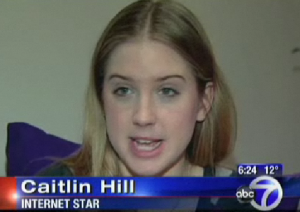 I’ve written before about Hitviews, and I’ve been working with the company on sponsored videos. This report (see video) by ABC’s NYC affiliate (channel 7), the most-watched local network in the US. It’s the story of how Hitviews co-founder Caitlin Hill (theHill88) and veteran network executives are turning online-video stars into promotional vehicles for large brands.
I’ve written before about Hitviews, and I’ve been working with the company on sponsored videos. This report (see video) by ABC’s NYC affiliate (channel 7), the most-watched local network in the US. It’s the story of how Hitviews co-founder Caitlin Hill (theHill88) and veteran network executives are turning online-video stars into promotional vehicles for large brands.
As the recession hits marketers, I’ve seen no sign of a slow-down in this sector. Online-video continues to grow, and advertising dollars are shifting to sites like YouTube. What I find fascinating about Hitviews model is that it has nothing to do with display or overlay advertising. Rather than rely exclusively on “paid” advertising, some progressive brands are sponsoring well-known creators. For example, even though my videos are viewed more than 100,000 a day, there are dozens of independent creators that are far more “subscribed” and viewed.
These amateurs, some with 300-500,000 views a day, offer advertisers a higher impact model to reach an engaged audience that eagerly await the next video of their favorite online-video stars. The audience trusts the star, and comment and reply. Meanwhile the stars are often 20-something kids who have a low cost of living, and are open to sponsorships and product placements that can be more profitable than, say, YouTube ad sharing. As a Product Director, I find a video about my brand exponentially more valuable than ads alone. As a traditional-media analog, consider the difference between a 30-second ad on American Idol and Coke cups on the judges table. The latter is an implied endorsement by the judges (and you may hate two of them, but probably not all four).
There are a few challenges, of course. And they’re non trivial, which is why few companies have cracked this nut…
- Most brands and even their agencies can’t establish relationships with these online-video stars on their own. Even if they do, the learning isn’t scalable.
- The bigger stars are primarily focused on their audience, and not branding or even “business.” That means agencies may be surprised that the video creators aren’t cow-towing to them like a subcontractor.
- Agencies and brands still don’t understand that sponsored videos are becoming both common and appropriate in social media (as long as the sponsor is disclosed), and partially controllable. The star won’t read from a script, of course, but the brand sponsor reviews all videos before they go live.
- The creative challenge is to entertain first, and promote second. That requires sponsors to give the stars some creative freedom and trust their instinct.
- Online-video stars sometimes have agents, but often are “one-act shows.” That means that some are professional, and others are child-like. What made them popular with viewers — edgy, autonomous– can undermine them when it’s time to face such things as deadlines and review processes.
- Finding stars take significant knowledge of the online-video community. Some are easy to work with, and others are a nightmare. Some get top views, but have images and videos that are not right for some brands. Some work for cheap, and others demand top dollars.
I’m biased because I like Hitviews model, but I honestly can’t think of how brands & agencies can tap these video creators without an intermediary. Trust me because I’ve been on both sides. As a video creator I’ve dealt with agencies that think of me as a subcontractor and want a bloody advertisement instead of an entertaining video that promotes. I’ve not yet seen a company that bridges this gap like Hitviews. There are talent agencies that represent individual stars, and companies like Poptent that help brands find amateur talent. But no clearinghouse for brands/agencies wanting to do sponsored videos with video stars. In online-video’s infancy (2006-2008) it wasn’t uncommon for a popular YouTuber to work directly with a brands (like I did with Mentos).
But for this new-media play to scale, there needs to be a larger entities that can help broker the relationship so the key constituents (at least three) can all get what they need:
- First, audiences must like the videos. Failing that, nothing else matters.
- Second, the “star” must feel comfortable with the brand, and feel compensated appropriately. The videos take time, but more importantly an excess of them will harm their relationship with the audience.
- Finally the advertiser (a brand team or its steward) must feel like their money is well spent, and see the sponsored video as worth more than a preroll, overlay or banner. I’ve only seen about two interactive agencies that understand this, and I know that will change this year. As long as agencies see this as a “media buy” it’s doomed.
